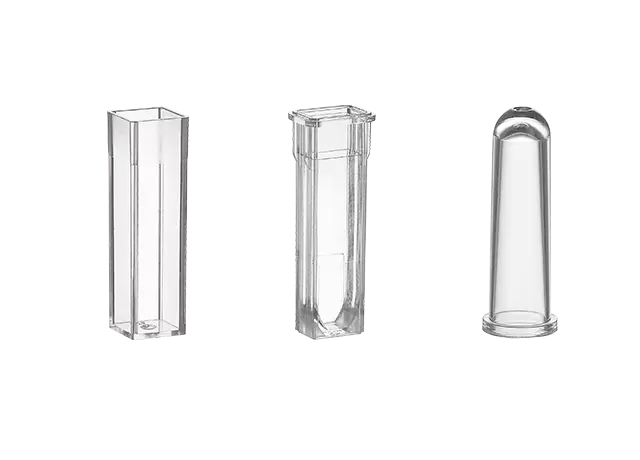- This topic is empty.
-
AuthorPosts
-
2024-10-12 at 4:06 pm #23552
In laboratory optical analysis, the cuvette cup is an indispensable basic tool. Although its design and function appear simple, its role is crucial, especially in spectroscopic analysis, where it provides essential support for the accurate determination of the optical properties of liquid samples. The use of the cuvette cups various fields of scientific research, including biology, chemistry, physics, and materials science, helping scientists analyze the chemical composition and concentration in samples. In this article, Kangjian will focus on the core role of the cuvette in spectroscopic analysis and its importance in ensuring stability and accuracy in spectroscopic experiments.

The Core Role of the Cuvette Cup in Spectroscopic Analysis
The cuvette cup plays a vital role in spectroscopic analysis. Its primary function is to enable the precise measurement of the optical properties of the sample. Spectroscopic analysis instruments allow light to pass through the liquid sample contained within the cuvette cup, measuring the changes in absorption or transmission that occur as the light passes through the sample. These measurements reveal the sample's optical properties at specific wavelengths. The quality, design, material, and optical accuracy of the cuvette cup directly influence the accuracy and stability of spectroscopic analysis.
Accurate Measurement of Sample Absorption and Transmission
Spectroscopic analysis techniques are widely used to determine the absorption or transmission of a sample at different wavelengths of light, thereby revealing the chemical composition or physical properties of the sample. In ultraviolet-visible (UV-Vis) spectroscopy and infrared (IR) spectroscopy, the cuvette cup is a key tool for achieving accurate optical measurements. Spectroscopic instruments send a beam of light through the sample in the cuvette cup and record the change in intensity after the light passes through the sample. The cuvette cup's two transparent surfaces provide a fixed path for the light, ensuring that experimental conditions remain controlled. The absorbance and transmittance data measured in this way can be used to calculate key parameters, such as the concentration of chemicals in the sample and the sample's optical properties.
Standardization of Optical Path Length
The cuvette cup is typically designed with a standardized optical path length, the most common being 1 cm. This fixed optical path length is crucial for data processing in spectroscopic analysis, especially in experiments following the Beer-Lambert Law. The Beer-Lambert Law states that absorbance is linearly related to the concentration of a substance in the solution and the optical path length. A fixed optical path length ensures that researchers can more reliably compare and reproduce experimental results when analyzing similar samples. The standardized optical path provided by the cuvette cup makes the sample measurement environment more uniform, eliminating deviations caused by different path lengths and ensuring predictable results and repeatable experiments.
Providing a Stable Optical Environment
The cuvette cup provides a controlled and closed optical environment. It protects the sample from external interference (such as air, humidity, or impurities) and ensures that light maintains a stable optical path when passing through the sample. Its precise design allows the light to pass vertically through the transparent surface of the cuvette cup, minimizing light scattering or deflection and thus ensuring the accuracy of spectroscopic measurements.
Ensuring Repeatability and Comparability of Experiments
Since the size, optical path length, and material of cuvette cups are standardized, experimenters can obtain consistent measurement results across different experimental setups and sample conditions. This standardization enhances the comparability of experimental data across laboratories and researchers. Whether in quantitative analysis (such as determining chemical concentrations in solutions) or qualitative analysis (such as identifying molecular structures), the cuvette provides a fundamental guarantee for the reliability of experimental results.
Stability and Precision of Cuvette Cups in Spectroscopic Experiments
The use of cuvette cups in laboratories requires high precision, particularly in spectroscopic analysis, where even slight errors can lead to significant deviations in data. The design of the cuvette cup must ensure a constant optical path while maintaining high-precision optical properties over long-term use.
Geometric Symmetry of the Cuvette Cup
The geometric design of the cuvette cup demands extreme accuracy, particularly regarding its two parallel transparent surfaces, which must be completely parallel and free from any optical defects or irregularities. This symmetrical design ensures that light is not deflected or scattered when passing through the cuvette cup, thus guaranteeing accurate measurements. If there is any asymmetry or minor deformation on the transparent surface of the cuvette cup, it will affect the light's path and result in measurement errors.
Resistance to Environmental Factors
Cuvette cups must exhibit strong resistance to external environmental factors. Variables such as temperature, humidity, and chemical corrosion can affect a cuvette cup's performance. For instance, high temperatures may cause the cuvette cup material to expand or alter its optical properties, which directly impacts the stability of the experiment. Therefore, high-end cuvette cups, especially those made of quartz, are often used in more extreme environmental conditions due to their superior thermal stability and chemical resistance.
Additionally, prolonged exposure to ultraviolet light and certain chemicals can degrade the material of the cuvette cup, reducing its transparency or altering its optical properties. As a result, researchers frequently inspect cuvette cups during long-term experiments to ensure that their optical characteristics remain unaffected by environmental influences.
Although the cuvette cup may seem like a simple tool, it plays a vital role in spectroscopic analysis. Not only does it provide a stable and standardized optical path, but it also ensures the accuracy and repeatability of spectroscopic measurements through its precise design and rigorous manufacturing processes. In scientific research and industrial applications, the cuvette cup is a cornerstone of optical analysis, helping researchers obtain accurate experimental data. Understanding the essential role of the cuvette cup in spectroscopic analysis experiments is fundamental to ensuring experimental success.
https://www.kangene.com/Industry-News/Cuvette-Cup-A-Precision-Tool-in-Optical-Analysis.html
https://www.kangene.com/Cuvette-Cup/
http://www.kangene.com
Jiangsu Kangjian Medical Supplies Co., Ltd. -
AuthorPosts
- You must be logged in to reply to this topic.